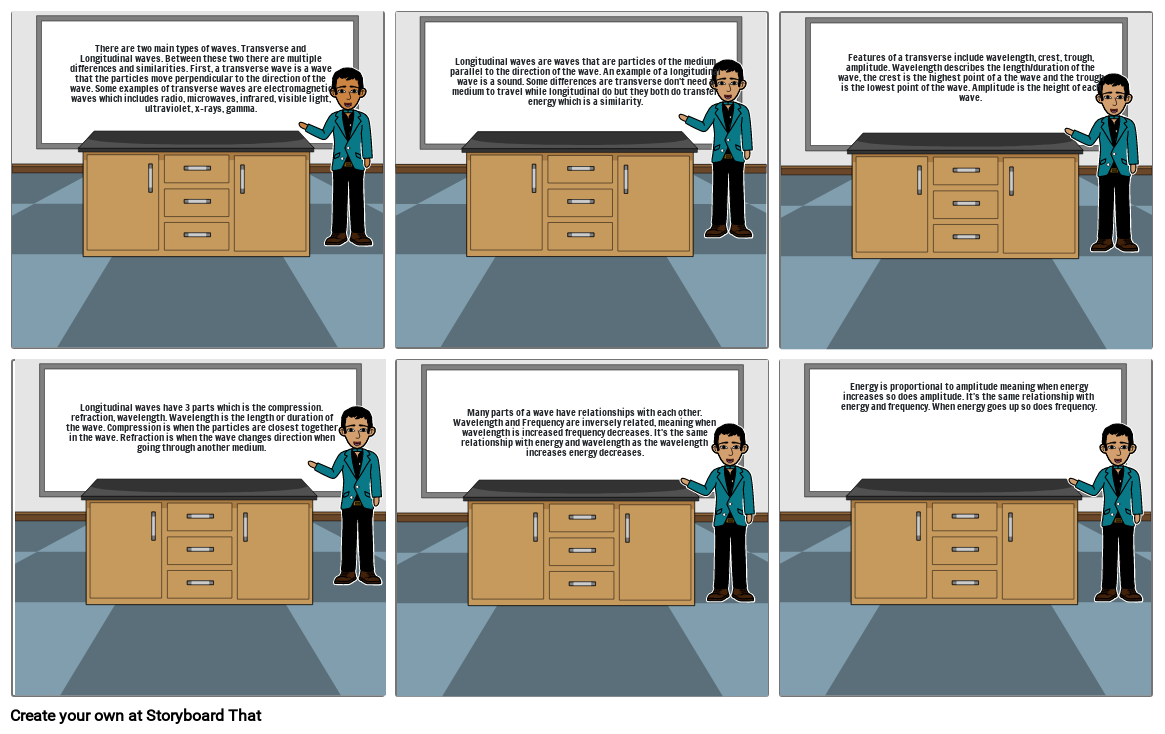Explaining Waves.

Texte du Storyboard
- There are two main types of waves. Transverse and Longitudinal Waves. Between these two there are many differences and similarities. First, A transverse wave is a wave that the particles of the medium move perpendicular to the direction of the wave. Some examples of Transverse waves are electromagneticwaves ( Radio, Microwaves, Infrared, Visible light, Ultraviolet, X-Rays, Gamma)
- There are two main types of waves. Transverse and Longitudinal waves. Between these two there are multiple differences and similarities. First, a transverse wave is a wave that the particles move perpendicular to the direction of the wave. Some examples of transverse waves are electromagnetic waves which includes radio, microwaves, infrared, visible light, ultraviolet, x-rays, gamma.
- Longitudinal waves are waves that are particles of the medium parallel to the direction of the wave. An example of a longitudinal wave is a sound. Some differences are transverse don't need a medium to travel while longitudinal do but they both do transfer energy which is a similarity.
- Longitudinal Waves are waves that the particles of the medium move parallel to the direction of wave. An example of a Longitudinal Wave is sound waves.
- There are two main types of waves. Transverse and Longitudinal Waves. Between these two there are many differences and similarities. First, A transverse wave is a wave that the particles of the medium move perpendicular to the direction of the wave. Some examples of Transverse waves are electromagneticwaves ( Radio, Microwaves, Infrared, Visible light, Ultraviolet, X-Rays, Gamma)
- Features of a transverse include wavelength, crest, trough, amplitude. Wavelength describes the length/duration of the wave, the crest is the highest point of a the wave and the trough is the lowest point of the wave. Amplitude is the height of each wave.
- Longitudinal waves have 3 parts which is the compression. refraction, wavelength. Wavelength is the length or duration of the wave. Compression is when the particles are closest together in the wave. Refraction is when the wave changes direction when going through another medium.
- There are two main types of waves. Transverse and Longitudinal Waves. Between these two there are many differences and similarities. First, A transverse wave is a wave that the particles of the medium move perpendicular to the direction of the wave. Some examples of Transverse waves are electromagneticwaves ( Radio, Microwaves, Infrared, Visible light, Ultraviolet, X-Rays, Gamma)
- Many parts of a wave have relationships with each other. Wavelength and Frequency are inversely related, meaning when wavelength is increased frequency decreases. It's the same relationship with energy and wavelength as the wavelength increases energy decreases.
- There are two main types of waves. Transverse and Longitudinal Waves. Between these two there are many differences and similarities. First, A transverse wave is a wave that the particles of the medium move perpendicular to the direction of the wave. Some examples of Transverse waves are electromagneticwaves ( Radio, Microwaves, Infrared, Visible light, Ultraviolet, X-Rays, Gamma)
- Energy is proportional to amplitude meaning when energy increases so does amplitude. It's the same relationship with energy and frequency. When energy goes up so does frequency.
- There are two main types of waves. Transverse and Longitudinal Waves. Between these two there are many differences and similarities. First, A transverse wave is a wave that the particles of the medium move perpendicular to the direction of the wave. Some examples of Transverse waves are electromagneticwaves ( Radio, Microwaves, Infrared, Visible light, Ultraviolet, X-Rays, Gamma)
Plus de 30 millions de storyboards créés

